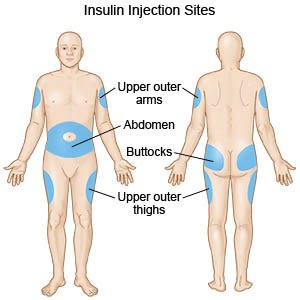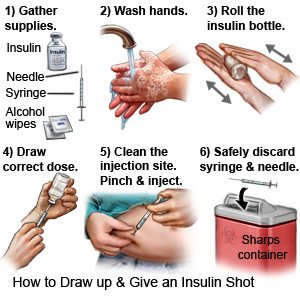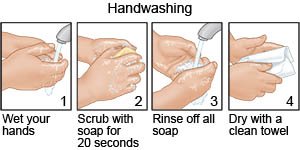How to Give an Insulin Injection
Medically reviewed by Drugs.com. Last updated on Apr 6, 2025.
What do I need to know about insulin syringes?
Insulin syringes come in different sizes depending on the dose of insulin you need. Your diabetes care team provider or pharmacist will help you find the right size syringe. Use the correct size insulin syringe to make sure you get the right dose of insulin.
Where do I inject insulin?
- You can inject insulin into your abdomen, upper arm, buttocks, hip, or the front or side of the thigh. Insulin works fastest when it is injected into the abdomen. Do not inject insulin within 2 inches of your belly button or into any stretch marks.

- Do not inject insulin into areas where you have a wound or a bruise. Insulin injected into wounds or bruises may not get into your body correctly. Do not inject insulin through your clothes. Injecting through clothes can contaminate the needle and may cause an infection.
- Use a different area within the site each time you inject insulin. For example, inject insulin into different areas in your abdomen. Insulin injected into the same area can cause lumps, swelling, or thickened skin.
How do I inject the insulin with a syringe?
 |
- Wash your hands with soap and water. This will help prevent an infection. Dry your hands with a clean towel or paper towel.

- Clean the skin where you will inject the insulin. You can use an alcohol pad or a cotton swab dipped in alcohol.
- Grab a fold of your skin. Gently pinch the skin and fat between your thumb and first finger.
- Insert the needle straight into your skin. Do not hold the syringe at an angle. Make sure the needle is all the way into the skin. Let go of the pinched tissue.
- Push down on the plunger to inject the insulin. Press on the plunger until the insulin is gone. Keep the needle in place for 5 seconds after you inject the insulin.
- Pull out the needle. Press on your injection site for 5 to 10 seconds. Do not rub. This will keep insulin from leaking out.
- Throw away your used insulin syringe as directed. Do not recap the syringe before you throw it away.
Drugs used to treat this and similar conditions
Lyrica
Lyrica is used to control seizures, treat nerve pain and fibromyalgia. Learn about side effects ...
Metoclopramide
Metoclopramide is used short-term to treat heartburn caused by gastroesophageal reflux. Learn about ...
Omvoh
Omvoh is used to treat moderate to severe ulcerative colitis or Crohn's disease in adults. This ...
Simethicone
Simethicone systemic is used for endoscopy or radiology premedication, functional gastric disorder ...
Metformin
Metformin is an oral diabetes medicine used together with diet and exercise to improve blood sugar ...
Gabapentin
Gabapentin is an anti-epileptic drug, also called an anticonvulsant. It is used to treat some types ...
Sodium bicarbonate
Sodium bicarbonate systemic is used for acidosis, alkylating agent cystitis, asystole, diabetic ...
Clopidogrel
Clopidogrel systemic is used for acute coronary syndrome, acute coronary syndrome, prophylaxis ...
Glucagon
Glucagon injection is used to treat low blood sugar and to stop stomach movement during x-ray ...
How can I decrease pain when I inject insulin?
- Inject insulin at room temperature. If the insulin has been stored in the refrigerator, remove it 30 minutes before you inject it.
- Remove all air bubbles from the syringe before the injection.
- If you clean your skin with an alcohol pad, wait until it has dried before you inject insulin.
- Relax the muscles at the injection site.
- Do not change the direction of the needle during insertion or removal.
Can I reuse my syringe?
You may increase your risk for a bacterial infection when you reuse syringes. Ask your diabetes care team provider if it is safe for you to reuse a syringe. Do not reuse a syringe if you have an open wound, trouble seeing, or have an infection. The following are tips on how to safely reuse a syringe:
- Recap the needle as soon as you are done using it. Place the cap on a table or hard surface and slide the needle into the cap.
- Do not let the needle touch anything but clean skin or the top of the insulin bottle.
- Never share syringes with anyone.
- Do not clean your needle with alcohol. This will remove the coating that helps your needle slide easily into your skin.
- Throw out any syringe that bends or touches anything other than clean skin.
Where should I get rid of my used syringes?
Ask your diabetes care team provider where to get rid of your syringes. He or she may tell you to place the syringe in a heavy-duty laundry detergent bottle or a metal coffee can. The container should have a cap that fits securely. Ask your local waste authority if you need to follow certain rules for getting rid of your syringes. Bring your used syringes home with you when you travel. Pack them in a plastic or metal container with a secure lid.
When should I call my doctor or diabetes care team provider?
- You feel or see hard lumps in your skin where you inject your insulin.
- You think you gave yourself too much or not enough insulin.
- Your injections are very painful.
- You see blood or clear fluid on your injection site more than 1 time after you inject insulin.
- You have questions about how to give the injection.
- You cannot afford to buy your diabetes supplies.
- You have questions or concerns about your condition or care.
Care Agreement
You have the right to help plan your care. Learn about your health condition and how it may be treated. Discuss treatment options with your healthcare providers to decide what care you want to receive. You always have the right to refuse treatment. The above information is an educational aid only. It is not intended as medical advice for individual conditions or treatments. Talk to your doctor, nurse or pharmacist before following any medical regimen to see if it is safe and effective for you.© Copyright Merative 2025 Information is for End User's use only and may not be sold, redistributed or otherwise used for commercial purposes.
Further information
Always consult your healthcare provider to ensure the information displayed on this page applies to your personal circumstances.
